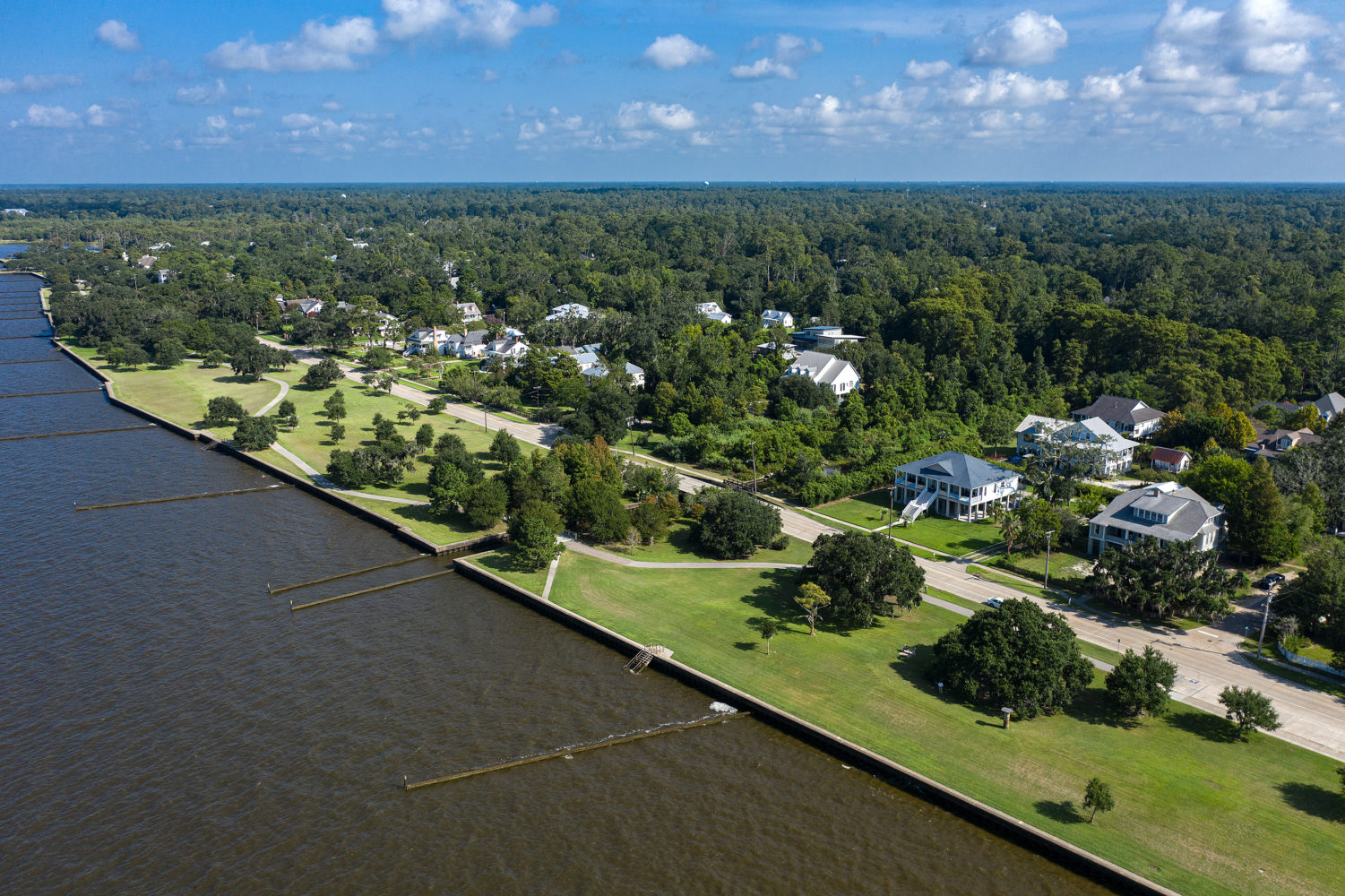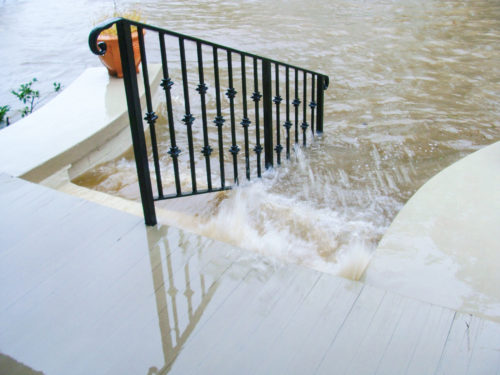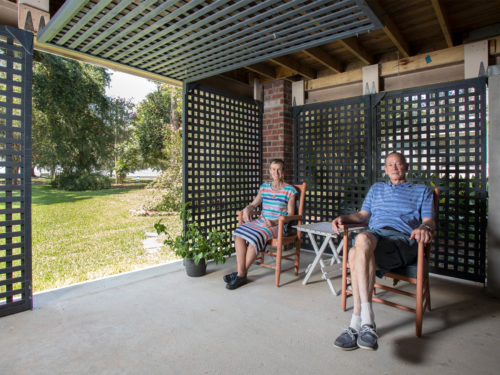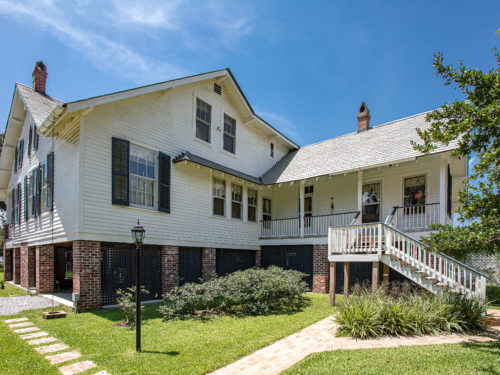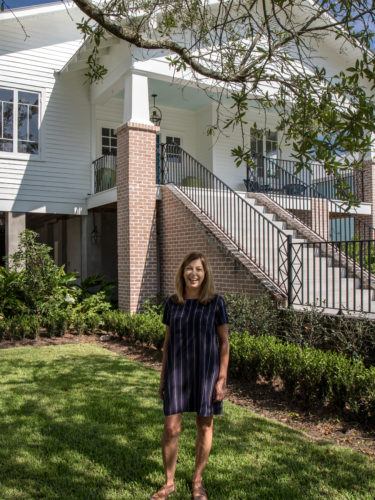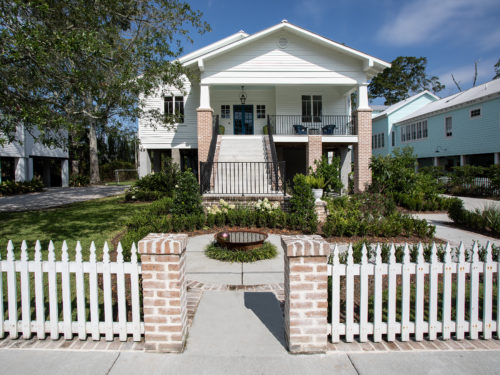This story appeared in the September issue of the PRC’s Preservation in Print magazine. Interested in getting more preservation stories like this delivered to your door monthly? Become a member of the PRC for a subscription!
The historic home at 2525 Lakeshore Drive in Mandeville has been in Leonard Rohrbough’s family since 1912. Built as a Creole cottage around 1843, the house has, on countless occasions, defied raging floodwaters from Lake Pontchartrain, about 100 yards to its south.
Located on a ridge in flood-prone Old Mandeville, the house has never taken in water through its antique doors, despite it being only about three feet off the ground for the first 170 years of its existence. However, Hurricane Katrina in 2005 and Hurricane Isaac in 2012 brought storm-whipped water within inches of the threshold.
Daunted by the near misses and the realization that rising sea levels further enhance the threat, Rohrbough and his wife, Becky, faced a dilemma: elevate the structure or face sky-high flood insurance rates and live with the risk of having a future storm lay it to waste, or at very least compromise the old home’s underbelly.
Flood photos courtesy of Becky Rohrbough.
Lifting the house was also a pricey option, well into six figures. But the couple knew that if the house was ever put on the market, potential buyers would demand a discount to cover the elevation.
Then, there was the issue of whether raising the house out of harm’s way would undermine its historical value, a question that loomed large for Becky Rohrbough, a preservationist who was president of the Old Mandeville Historic Association. “It was gut-churning,” Becky Rohrbough said, referring to the decision of whether to elevate the irreplaceable lakefront home. “We didn’t want to ruin the house.”
In January 2015, the couple moved out of their house and began a nine-month project to lift the structure off of its original and partially crumbling 64 short piers. Upon completion, the lowest interior level of the house was raised to just under nine feet above the ground, about six feet higher than it was before.
The Rohrbough home is now among the approximately 70 percent of structures that have been elevated in Mandeville’s historic district, which stretches about a mile and a half along Lakeshore Drive and several blocks north of the shoreline. The Rohrboughs said they are more than happy with the finished product, despite its cost.
The couple followed a relatively new set of local government guidelines designed to enhance the aesthetics and protect the historical integrity of historic homes undergoing major changes. The couple said jumping through the hoops was no picnic, but well worth the effort.
“People started complimenting us, and we had some tell us it looks better than ever,” Becky Rohrbough said. “As one architect put it, ‘you nailed it.’”
[twentytwenty]
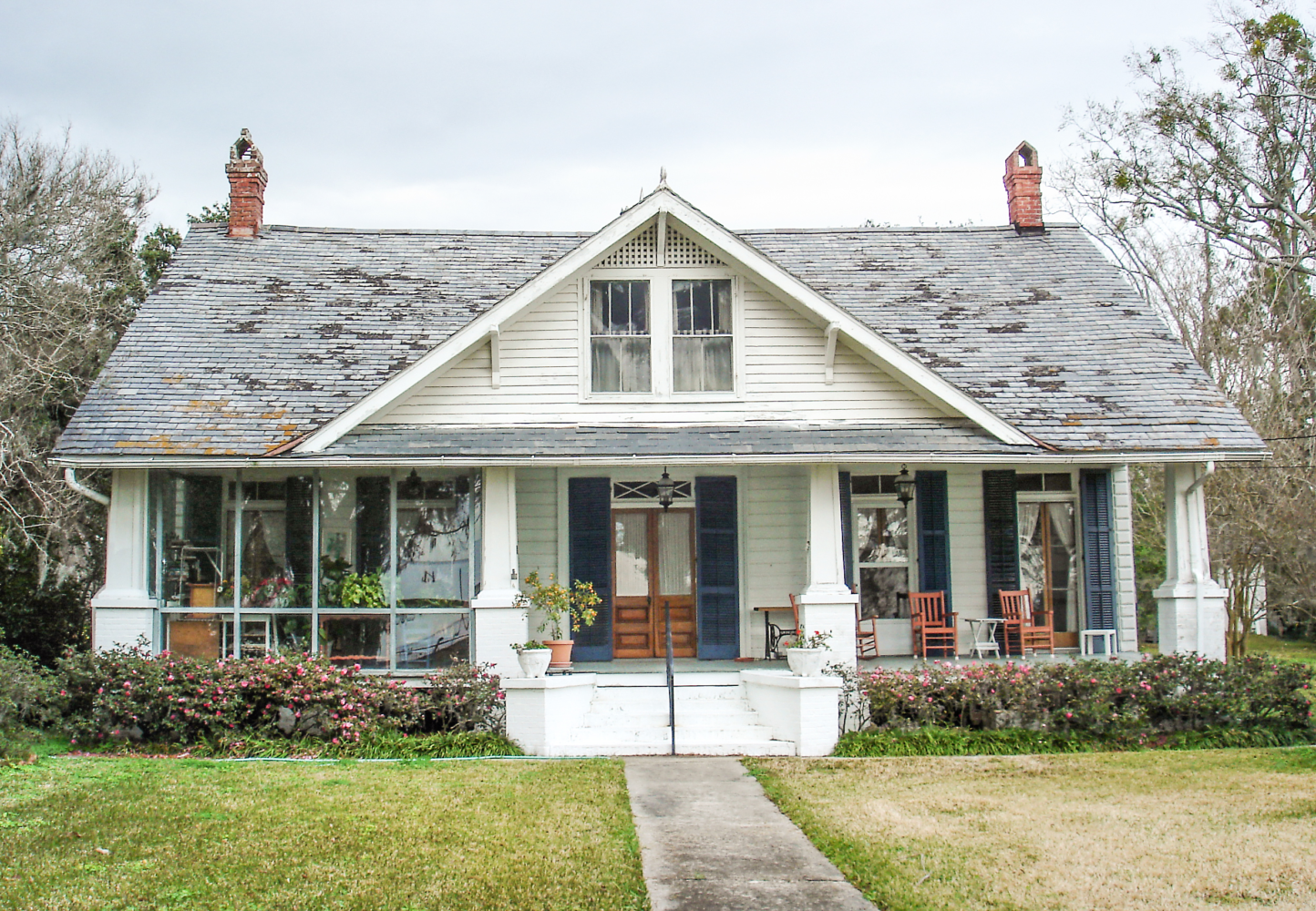
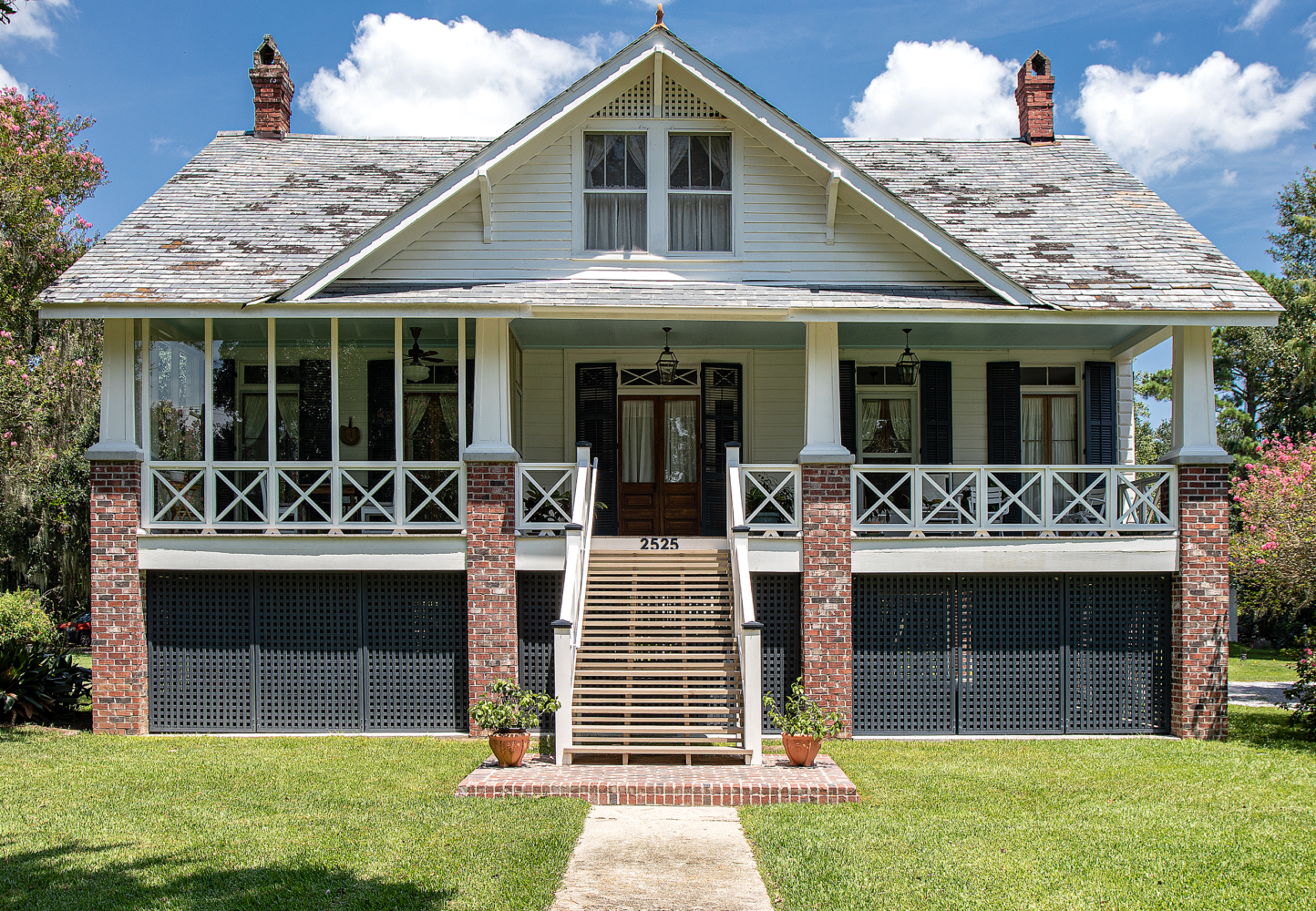
[/twentytwenty]
The house at 2525 Lakeshore Drive has been in Leonard Rohrbough’s family since 1912. Though the house never flooded, water came within inches of its threshold in two hurricanes. To prevent flooding, the Rohrbough’s elevated the house in 2015. Photos by Charles E. Leche.
Mandeville is one of several waterfront communities in the country taking the lead in dealing with mitigating flood hazards in historic districts. Charleston, S.C., and Annapolis, Md., are among others that have grappled with the issue by establishing guidelines to incorporate historic property into hazard mitigation planning and improve the appearance of elevated structures.
“Charleston’s narrow downtown streets, with homes dating back a century or more, are seeing as many as three homeowners on the same block attempt to lift their houses,” according to an Aug. 2 article by Chloe Johnson and Stephen Hobbs in Charleston’s Post and Courier newspaper. “Back-to-back storms that caused extensive flooding and the threat of bigger tides are convincing many to go higher.”
According to the newspaper, at least 50 homeowners in Charleston’s historic district have inquired about elevating their homes, “a practice the city once discouraged but now largely accepts after a spate of recent floods and the growing reality of climate change.”
In June, the city of New Orleans announced that $12.5 million in grant funding from the Federal Emergency Management Agency’s Flood Mitigation Assistance program will pay for the elevation of more than 50 “pre-identified homes in New Orleans that have experienced repeated and severe flooding.” Twenty-one of those houses are in Broadmoor, a National Register Historic District.
Advertisement
Roderick Scott, flood hazard mitigation specialist for Mandeville-based L&R Resources, LLC, said Mandeville has emerged as the nation’s “laboratory” on how to balance the goals of flood mitigation and historic preservation. The city started addressing the issue after Hurricane Katrina in 2005 and “never looked back,” he said.
The issue gains significance with each passing storm. Climate change will continue to dramatically impact coastal and riverine communities with more frequent and intense storms and associated flooding, Scott said, noting Mandeville has experienced eight hurricane floods since Hurricane Katrina in 2005, plus numerous high water events not directly attributable to a named storm.
It is in part climate change that prompted reforms to the National Flood Insurance Program, which has led to higher bills for property owners in flood-prone areas. The Biggert-Waters Act of 2012 gradually increased flood insurance rates to match actuarial risks, removed discounts and eliminated the grandfathering of older rates.
As rates rise, homes in coastal communities in high flood risk zones like the Mandeville lakefront could soon be facing flood insurance rates of $10,000 a year or more if their living spaces remain close to the ground, Scott said.
Hinged lattices that surround the ground floor can be easily folded up to open the space for parties and family gatherings, said Leonard and Becky Rohrbough. Photos by Charles E. Leche.
Louisette Scott, Mandeville’s planning director and Roderick Scott’s wife, said local governments can address the issue by establish guidelines allowing structures to be raised above flood threats while maintaining their historical value. Without such guidelines, irreplaceable old homes located along shorelines can be made to look like fishing camps plopped atop cinder-block columns, leaving their historical value to wash away with the next high tide. Historic structures in places that either didn’t have restrictions or were elevated before restrictions were established can create the appearance of a community on stilts. It is the specter of such a streetscape that has led preservationists to rise up against elevating historic structures.
“I can understand why there was so much resistance,” Louisette Scott said. “I’ve been to places and said, ‘Oh my gosh, that house has been elevated, and it looks terrible up there.’”
Louisette Scott was one of three panelists who took part in a discussion on climate change and historic preservation hosted last May by the Preservation Resource Center and the Lake Pontchartrain Basin Foundation. Held at the New Canal Lighthouse on the New Orleans lakefront, the other panelists were Chris Cook, director of the New Canal Lighthouse Museum, and Bryan D. Block, director of the Vieux Carré Commission.
Advertisement
When he first began discussing the elevation of homes in historic districts, Iowa native Roderick Scott said he was viewed as a Darth Vader of sorts among preservationists. That’s no longer the case, he said.
The Scotts said representatives from the National Park Service, which administers the National Register of Historic Places and oversees the federal historic rehabilitation tax credits, have toured Mandeville’s lakefront to see historic homes that have been hoisted to avoid flood damage.
“Flooding constitutes an existential threat to historic districts and the view on elevating historic buildings has evolved,” said Roderick Scott, who along with his wife gave a presentation on the issue at the National Trust for Historic Preservation conference in San Francisco last fall.
To elevate a structure in Mandeville’s historic district, an owner must adhere to guidelines put in place by the city in 2013. Part of the process involves getting approval from an architectural review board and permission from a city preservation commission charged with protecting the historic community’s cherished ambiance. Approximately 64 historic structures have been elevated since the City Council enacted the guidelines six years ago. Prior to 2013, the city did not keep a count.
In 2015, when Maureen Connell purchased this cottage near the lake in Old Mandeville, the house showed signs of previous flooding. To prevent future water damage, Connell elevated the home as she renovated and enlarged the property. Photos by Charles E. Leche.
Maureen Connell, a real estate agent with Meredith Escher McMath, owns one of those structures. In 2015, she purchased an arts and crafts-style cottage less than a half-block from the lake in Old Mandeville. Built between 1916 and 1920, the 1,100-square-foot home had several water marks at the level of its electrical outlets.
Fearing more floods and rising insurance rates and wanting more living area, Connell elevated and enlarged the home. The project, which called for raising the house to about 10 feet off the ground, was done with great adherence to history. She sought out vintage brick for the expansion and worked her way through the gauntlet of city regulations.
“It was a charming little house, and I didn’t want to mess up that charm,” Connell said. “There were times when I felt like I was flying by the seat of my pants and about halfway through I asked myself ‘What have I gotten myself into.’ But I’m very happy with the way it all turned out.”
While the historic community fights the flooding battle on one front, lakeshore resident Gerard Braud, an expert in crisis communications and media issues, believes the local government needs to do more to stop water from inundating the historic community. He proposes a multi-step process that involves the installation of flood gates along ravines that feed the lake, creating a “splash zone” in the lake a short distance from shore to help prevent waves from splashing over the five-foot sea wall and bringing in pumps to empty flood water.
Even if floodwaters don’t enter homes, Braud said rising water from minor storms or stiff easterly winds can destroy gardens, cause major inconveniences and leave homeowners with a giant mess to clean up. “I support the concept of raising homes,” said Braud, who lives in an elevated house that was built in 1994 to replace a slab-on-grade home that had been repeatedly damaged by floods. “I believe every home should be elevated. The city considers this nuisance flooding, but it’s a big freaking nuisance.”
Advertisement
The city has studied several options to stem the flooding, including raising the sea wall, a move that many feel is undesirable because it would at least partially obstruct the view of the lake. Top level flood protection could cost as much as $30 million, officials have said.
Despite the flooding nuisance, Old Mandeville remains an immensely popular place. Full of history and embellished by oak trees that rival those in New Orleans City Park, the historic district has a charm and a legacy not often found in suburbs. Bernard de Marigny de Mandeville, referred to by historians as a nobleman, playboy, gambler, planter, politician and land developer, founded Mandeville in 1834.
His family, members of New Orleans’ upper echelon of society, owned about one-third of the Crescent City. In the early 1800s, the family subdivided one of the Marigny plantations to form the Faubourg Marigny neighborhood next to the French Quarter.
Marigny ran unsuccessfully for governor of Louisiana three times and operated a plantation on what is now Fontainebleau State Park. He also held title to a portion of land along Lake Pontchartrain that was noted for its firmness, despite being lapped upon by lake waters, according to historical records. He ordered a street grid to be drawn on that relatively high and solid ground, and thus the early lakefront town of Mandeville took form.
The property along the lakefront became home to hotels, gaming halls and social gathering places. Many of the residential plots in Marigny’s Old Mandeville were purchased as summer homes by wealthy New Orleanians whose pre-Causeway treks across the lake came via steamships. Steamship service between New Orleans and Mandeville ended in 1936.
This year, more tickets were sold — around 600 — than in any other year to the Old Mandeville Historic Association’s annual Mother’s Day Home Tour. The Rohrbough home was one of seven historic residences open for visitors taking the tour.
Roderick Scott said he believes elevating historic homes in flood zones, like the Rohrboughs’ residence, is the best way to keep them around for future generations to appreciate. “If we don’t, these homes are just sitting ducks,” he said.
Story by Kim Chatelain. Photos by Charles E. Leche.
Advertisements




